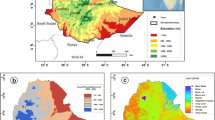Abstract
The vertical structure of water vapor in atmosphere is one of the initial information of numerical weather forecast model. Because of the strong variation of water vapor in atmosphere and limited spatio-temporal solutions of traditional observation technique, the initial water vapor field of numerical weather forecast model can not accurately be described. At present, using GPS slant observations to study water vapor profile is very popular in the world. Using slant water vapor(SWV) observations from Shanghai GPS network, we diagnose the three-dimensional(3D) water vapor structure over Shanghai area firstly in China. In water vapor tomography, Gauss weighted function is used as horizontal constraint, the output of numerical forecast is used as apriori information, and boundary condition is also considered. For the problem without exact apriori weights for observations, estimation of variance components is introduced firstly in water vapor tomography to determine posteriori weights. Robust estimation is chosen for reducing the effect of blunders on solutions. For the descending characteristic of water vapor with height increasing, non-equal weights are used along vertical direction. Comparisons between tomography results and the profile provided by numerical model (MM5) show that the forecasted moisture fields of MM5 can be improved obviously by GPS slant water vapor. Using GPS slant observations to study 3D structure of atmosphere in near real-time is very important for improving initial water vapor field of short-term weather forecast and enhancing the accuracy of numerical weather forecast.
Similar content being viewed by others

References
Li Chengcai, Mao Jietai, Li Jianguo et al., Remote sensing of water vapor by GPS, Chinese Science Bulletin 1999, 44(3): 333–336.
Flores, A., Ruffini, G., Rius, A., 4D tropospheric tomography using GPS slant wet delays, Annales Geophysicae, 2000, 18: 223–234.
Lubomir, P., Per JarLemark, Ground-Based GPS Tomography of water vapor: analysis of simulated and real data, Journal of the Meteorological Society of Japan, 2004, 82(Special issue): 551–560.
Ulrich Foelsche, Tropospheric water vapor imaging by combination of ground-based and spaceborne GNSS sounding data, J. Geophy. Res., 2001, 106(D21): 27221–27231.
Ha, S. Y., Guo, Y. R., Roken, C., Comparison of GPS Slant Wet Delay Measurements with Model Simulations during the Passage of a Squall Line, Geophys. Res. Lett., 2002, 29(23): 2113–2116.
Song Shuli, Zhu Wenyao, Ding Jincai et al., Near Real Time Sensing of PWV from SGCAN and the application test in Numerical Weather Forecast, Chinese Journal of Geophysics, 2004, 47(4): 631–638.
Shoji, Y., Nakamura, H., Iwabuchi, T. et al., Tsukuba GPS Dense Net Campaign Observation: Improvement of GPS analysis of slant path delay by stacking one-way postfit phase residuals, in Proceeding of International Workshop on GPS Meterology, Japan, 2003, 1-05-01–1-05-6.
Rocken, C., Braun, J., Vanhove, T. et al., Developments in ground-based GPS Mmeteorology, in Proceeding of International Workshop on GPS Meterology, Japan, 2003, 1-01-1–1-01-6.
Song Shuli, Zhu Wenyao, Liao Xinhao et al., GPS slant water vapor estimation method, Chinese Astronomy and Astrophysics, 2004, 47(3): 338–346.
Author information
Authors and Affiliations
Corresponding author
About this article
Cite this article
Song, S., Zhu, W., Ding, J. et al. 3D water-vapor tomography with Shanghai GPS network to improve forecasted moisture field. CHINESE SCI BULL 51, 607–614 (2006). https://doi.org/10.1007/s11434-006-0607-5
Received:
Accepted:
Issue Date:
DOI: https://doi.org/10.1007/s11434-006-0607-5



